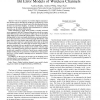Free Online Productivity Tools
i2Speak
i2Symbol
i2OCR
iTex2Img
iWeb2Print
iWeb2Shot
i2Type
iPdf2Split
iPdf2Merge
i2Bopomofo
i2Arabic
i2Style
i2Image
i2PDF
iLatex2Rtf
Sci2ools
INFOCOM
2003
IEEE
2003
IEEE
Chaotic Maps as Parsimonious Bit Error Models of Wireless Channels
Abstract—The error patterns of a wireless digital communication channel can be described by looking at consecutively correct or erroneous bits (runs and bursts) and at the distribution function of these run and burst lengths. A number of stochastic models exist that can be used to describe these distributions for wireless channels, e.g., the Gilbert-Elliot model. When attempting to apply these models to actually measured error sequences, they fail: Measured data gives raise to two essentially different types of error patterns which can not be described using simple error models like Gilbert-Elliot. These two types are distinguished by their run length distribution; one type in particular is characterized by a heavy-tailed run length distribution. This paper shows how the chaotic map model can be used to describe these error types and how to parameterize this model on the basis of measurement data. We show that the chaotic map model is a superior stochastic bit error model for such ch...
| Added | 04 Jul 2010 |
| Updated | 04 Jul 2010 |
| Type | Conference |
| Year | 2003 |
| Where | INFOCOM |
| Authors | Andreas Köpke, Andreas Willig, Holger Karl |
Comments (0)

